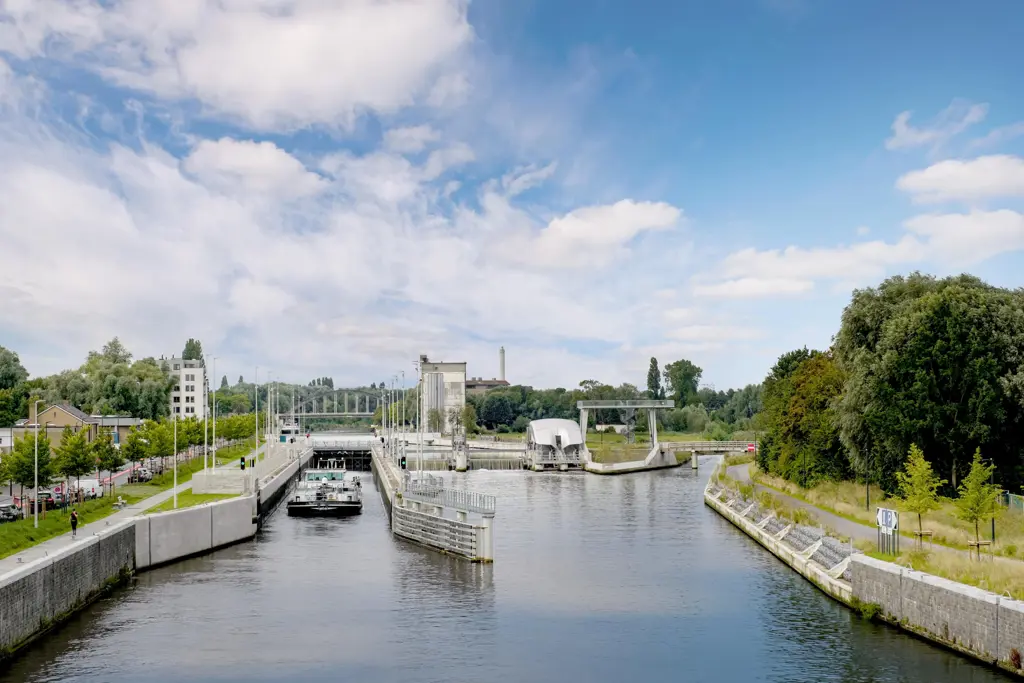Sluiscomplex in de Leie, Harelbeke
Description
Een nieuwe sluis
Stromend vanuit Frankrijk, ondervindt de Leie vanaf Kortrijk naar de Schelde bij Gent minder en minder verval, en vormde dus gedurende vele eeuwen het karakteristieke Vlaamse landschap met zijn dorpen en steden langs de beboste, meanderende oevers. De laatste twintig jaar is de rivier op veel plaatsen rechtgetrokken en uitgediept, om grotere binnenvaartschepen tot aan Rijsel te laten varen. In het kader van het plan om voor de grootste schepen de verbinding te maken van de Schelde naar het bekken van de Seine bij Parijs, is bij Harelbeke de sluis ingrijpend vergroot en vernieuwd.
De relatie tot de rivier herstellen
Samen met landschapsarchitect Bureau Bas Smets leverde architectenbureau ZJA het ontwerp voor de nieuwe situatie, waarin de noodzaak van de nieuwe sluis de aanleiding is voor een ingrijpende revitalisering van de relatie tussen Harelbeke en de Leie. Ook bij Harelbeke ligt namelijk een afgedamde arm van de Leie. Het water omsloot een klein, sleets eiland waar oude fabrieksgebouwen en watermolens staan. In Harelbeke, aan de overkant, was er asfalt om te parkeren tot aan de kade, die was afgezet met vangrails. Alle kades waren hoog en hard. De mensen leefden er met hun rug naar de rivier.
Door de Banmolensbrug en het ecologisch herstel van de geopende Leie-arm met groene oevers kan het Moleneiland ontwikkeld worden tot een groene omgeving om te wonen en recreëren. In het ontwerp van ZJA is voorzien dat het industrieel erfgoed wordt herontwikkeld met een publieke functie die bezoekers trekt. De oevers worden aan beide zijden comfortabele plekken om te verblijven door de aanleg van groen, terrassen en trappen.
Sierlijke bruggen
In het Masterplan voor het Moleneiland is een vlakke, comfortabele fietsverbinding in één rechte lijn van de nieuwe Molenwijk op de westoever, via het Moleneiland tot de stadskern van Harelbeke op de oostoever getekend. Hierbij zijn twee wandel- en fietsbruggen ontworpen. Over de Leie is het een lichtgekleurde, elegante brug, die als het nodig is open draait. Dat is een mooi gezicht, het lange brugdek dat gesteund door het deels verborgen contragewicht traag over het water beweegt; de uitgestoken arm van een danseres die een pirouette maakt. Over de Oude Leie-arm is het een kortere klapbrug. Op het Moleneiland is een parkachtige omgeving gepland, waar een wandelpad is over de vistrap, die vissen gelegenheid geeft zonder gevaar de sluis te passeren. Op de punt van het eiland is een getrapt terras dat uitzicht geeft op de activiteit bij de sluis, het vijzelgemaal en de omgeving. Volgens het masterplan kan er in de toekomst een jachthaven in het hart van het Moleneiland worden aangelegd.
De Hogebrug over de Leie is een zo laag en kort mogelijke boogbrug, die zich vloeiend verbreedt in het midden. Het staal is in zacht papyruswit geschilderd. Met zijn ruime wandelpaden, transparante hekken en de houten banken langs de beide zijden is het ook een verblijfsplek om bij goed weer te zitten en over het water uit te kijken. De onderzijde van de brug is met zorg en vriendelijk vormgegeven, en ’s avonds goed verlicht om de eronder passerende voetgangers en fietsers een veilig gevoel te geven.
Het gezicht naar de Leie
Ook de grotere nieuwe sluis en het ernaast gelegen vijzelgemaal maken in dit ontwerp deel uit van het rivierlandschap. Voor zover dat veilig is, is de ruimte rondom het complex toegankelijk voor voetgangers, om de beleving van de rivier en het schutten van de schepen dichterbij te brengen. Speciaal vormgegeven hekwerken zorgen voor de veiligheid. De nieuwe sluis is een enorme nautische verbetering die de binnenvaart een economische impuls zal geven, maar het was ook een aanleiding om Harelbeke en haar inwoners weer met het gezicht naar de Leie te laten leven en de oplevende natuur, de cultuurgeschiedenis van het Moleneiland en de schoonheid van het Vlaamse landschap te beleven. Wie leeft van de rivier moet haar ook bekijken, bewonderen, koesteren en die mogelijkheid biedt de nieuwe situatie bij Harelbeke volop.
Architect: ZJA
Klant: De Vlaamse Waterweg
Opdrachtgever: THV Leieland (Jan De Nul, Herbosch-Kiere, Engie Fabricom en Aelterman bvba)
Aannemer: Herbosch –Kiere
Landschapsarchitect: Bureau Bas Smets
Technisch ontwerp: SBE
[English]
A new lock
Flowing from France towards the Schelde near Gent, the river Leie encounters less and less drop beyond Kortrijk, shaping the characteristic Flemish landscape with its cities and villages along its wooded, meandering banks through the centuries. In the last twenty years the river has been straightened and deepened in many places to enable larger ships to reach Rijsel. As part of the project to establish an inland shipping connection for the largest ships from the river Schelde to the Seine near Paris, a new and bigger lock in Harelbeke has been built.
To restore the relationship with the river
In collaboration with landscape architect Bureau Bas Smets, the architectural studio ZJA signed for the design of the new situation, in which the necessity of a new lock offered the opportunity to revitalize the relationship between Harelbeke and the Leie. At this site we also find one of those obsolete meanders of the Leie, now dammed off. The water enclosed a small neglected island with old factory buildings and water mills. In Harelbeke, across the river, asphalt and parking lots stretched right to the river, fenced off with steel crash barriers. All the quays were high and hard. People lived here with their back to the river.
In the new situation the dam has disappeared, and a bridge, the Banmolensbridge has been built. This, and the ecological recuperation of the re-opened meander of the Leie with its green banks allows the Molen island to be re-developed into a green space to live and play. In the design by ZJA the industrial heritage receives a public function to draw visitors. Both banks of the river will be transformed into pleasant environments to linger by introducing green patches, terraces and steps.
Elegant bridges
In the master plan for the Molen island a flat and easy bicycle path connection has been designed, in a straight line from the new Molenwijk neighbourhood on the westbank, via the Molen island all the way to the city centre of Harelbeke on the east banks. This includes the design of two bicycle - and pedestrian bridges. Across the river is a slender, light coloured bridge, that will open by turning sideways when needed. It is a magnificent sight to see the long deck of the bridge, supported by the partly hidden contra weight to move across the water; the extended arm of a dancer making a pirouette. Across the arm of the Leie behind the island is a shorter drawbridge. The island itself will offer a park like environment, with a path crossing the so called ‘stairs for fish’ giving fish the opportunity to pass the lock and the pumping engine unharmed. At the tip of the island a terrace with multiple levels offers a view of the activities at the lock and the surrounding landscape. According to the master plan, a marina can be built at the heart of the Molen island in the future.
The Hogebrug across the Leie is a bridge with an arch designed to be as low and short as possible, and a deck that gradually widens in the middle. The steel girders are painted in soft papyrus white. With its wide pedestrian paths, transparent railing and wooden benches on both sides halfway, it is a pleasant spot to linger with good weather and overlook the river. The underside of the bridge is designed with care to be friendly and well lit, giving pedestrians and cyclists passing underneath a sense of safety at night.
Facing the Leie
In this design the new lock and the pumping engine with the Archimedean screw next to it are both part of the river landscape. As far as safety allows the space around this complex is accessible to pedestrians, to better experience life on the river and the locking in and out of the ships. Custom designed fences ensure their safety. The new lock is a vast nautical improvement which will give inland shipping an economical impulse, and also offered the opportunity to turn Harelbeke and its residents with their faces towards the river once again, so they can enjoy the cultural history, the recovering natural environment and the beauty of the Flemish landscape. When your livelihood depends on the river, needs to also experience, admire and cherish her and this all is what the new situation in Harelbeke offers in abundance.
Architect: ZJA
Client: De Vlaamse Waterweg
Principal: THV Leieland (Jan De Nul, Herbosch-Kiere, Engie Fabricom and Aelterman bvba)
Contractor: Herbosch –Kiere
Landscape architect: Bureau Bas Smets
Technical design: SBE
Expertise: Architecture Awards: Winner: Popular choice award of the Publica Award 2020, Nomination: Jury award of the Publica Award 2020 Features or Specials: Bridge construction, Structural design

Werk ook slimmer met Galleo
Galleo brengt projectdata, kennis en AI samen in één veilige, schaalbare oplossing. Toonaangevende bedrijven zoals ABT, Movares, CLAFIS en Witteveen+Bos kiezen al voor Galleo. Sluit je aan.
Neem contact op met Barbara of Kars
We werken zelf in de gebouwde omgeving en adviseren je graag, met praktijkervaring en vakkennis, over wat het beste werkt voor jouw organisatie.
Neem contact op